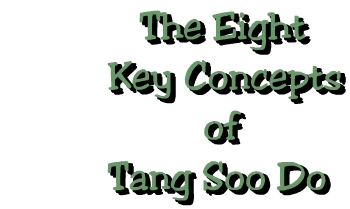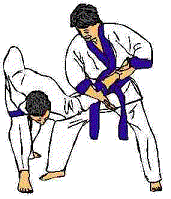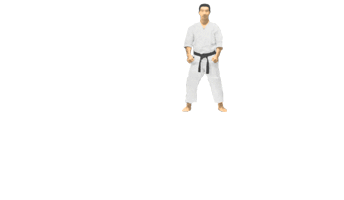






Tang Soo Do is a Korean Martial Art with influences from the North and South Chinese and the Okinawan disciplines of Karate. Kwan Jhang Nim (Grandmaster) Charles Ferraro, founder of the Mi Guk Kwan system started his training in 1967 under Mr. Robert Cheezic in Tang Soo Do Moo Duk Kwan. For a more detailed history, you can visit the TSDMGK Association website.
 |
These Korean Symbols located at the bottom of the patch stand for Tang Soo Do Mi Guk Kwan,(Brotherhood or school in America where the way of the empty hand defense is practiced). |
The Belt System of Tang Soo Do
|
Belt Color
|
Season
|
Meaning
|
|
White
|
Winter
|
Hidden
Potential, Emptiness
|
|
Orange
|
Early
Spring
|
Awareness
of Potential, Desire
|
|
Green
|
Spring
|
Growth,
Advancement,Life, Peace
|
|
Red
|
Summer
|
Ripening,
Active,Yang
|
|
Midnight
Blue
|
Autumn
|
Harvest,Passive,Maturity,Success
|
In the discipline of Tang Soo Do the "blackbelt" is not black, but midnight blue. The reason behind this as explained to me by Master Yong Gi Hong was that in the old days, students wore a white belt throughout their training. Over time the belt got dirty. You are not suppose to wash your belt because it contains all your knowledge and if you wash it, you wash away your knowledge. When a student trained for a long time, his belt turned black and that is where the term blackbelt came from. But what about the midnight blue? In Tang Soo Do it is believed that there is always something to learn and your belt can always get dirtier. When you look up to the heavens at night the sky is not black, but dark midnight blue and it is endless, just as the knowledge we learn is endless. So that is why our blackbelt is midnight blue.
A Tang Soo Do Mi Guk Kwan practitioner always strives to improve.........
.................... .
.
|
Yong Gi- Courage |
Chun Shin Tong Il- Concentration |
|
|
In
Neh- Endurance
|
Chung Jik- Honesty
|
|
|
Kyum Son- Humility |
Him
Cho Chung- Control of Power
|
|
|
Shin
Chook- Tension and Relaxation
|
Wan
Gup- Speed Control
|
|
 |
 |
|
Why do martial artists break boards? Let me tell you from experience that it is not as easy as it looks. It takes a certain degree of skill, concentration and control of power to break that board. As students develop through the ranks, the breaks become more difficult, for instance a white belt testing for an orange belt is required to break using any learned hand technique. To complete testing requirements for blackbelt, the break consists of a jump back kick at chin level of the breaker. Not so easy if you haven't trained for it! |
|

Form training can be considered meditation in motion for it requires both mental and physical discipline. Forms are in a sense a series of techniques, both offensive and defensive, that simulate a fight sequence. It takes alot of practice to develop a form and make it your own. This animation, although it is not a Tang Soo Do form, shows the moves in a basic form.
Free sparring is another aspect of training. It combines the knowledge learned by basic drills, form training, one step sparring and self defense moves learned in class. Students must wear protective headgear, a mouth guard,safety gloves and boots and groin protection. Students are also allowed to optionally wear forearm and shin guards. Sparring in class gives the students an opportunity to learn timing, offensive and defensive techniques while helping their fellow student do the same. Tang Soo Do does not practice full contact sparring. In competition, competitors earn points for controlled contact to the front and sides of the body. Contact to the face, groin or back is not permitted.


Defending yourself against an attack is the basis for all self defense techniques. Beginners start with basic hand grabs consisting of one hand then progressing to two. By practicing the moves a Practitioner trains their muscles and mind to memory. Advanced students learn defense against bo staff and knife attacks.
|
|


